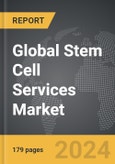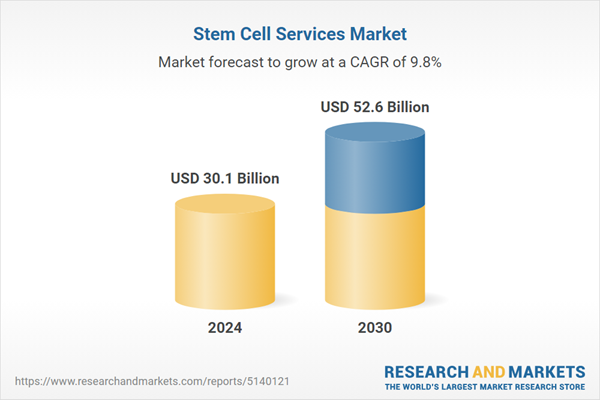The global market for Stem Cell Services was valued at USD 30.1 Billion in 2024 and is projected to reach USD 52.6 Billion by 2030, growing at a CAGR of 9.8% from 2024 to 2030. This comprehensive report provides an in-depth analysis of market trends, drivers, and forecasts, helping you make informed business decisions.
Global Stem Cell Services Market - Key Trends and Drivers Summarized
Why Are Stem Cell Services Essential for the Future of Regenerative Medicine?
Stem cell services are becoming essential for the future of regenerative medicine, offering a wide range of solutions that support stem cell research, development, and commercialization. These services include stem cell banking, expansion, differentiation, characterization, and quality control, which are crucial for ensuring the safety, efficacy, and scalability of stem cell-based therapies. The rising demand for cell and gene therapies, tissue engineering, and personalized medicine is driving the adoption of stem cell services across the healthcare industry. With increasing awareness about the therapeutic potential of stem cells, both public and private sectors are investing heavily in stem cell research and biomanufacturing, creating a strong foundation for the growth of stem cell services. The expanding applications of stem cell services in clinical research, disease modeling, and drug screening further highlight their importance in advancing next-generation therapeutics.How Are Technological Advancements Transforming Stem Cell Services?
Technological advancements in cell culture, cryopreservation, and quality control are transforming stem cell services, enabling more efficient, reliable, and scalable solutions. Innovations in automated cell expansion systems, closed bioreactor technologies, and digital biobanking are enhancing the safety, reproducibility, and cost-effectiveness of stem cell services. The integration of gene editing technologies, such as CRISPR-Cas9, with stem cell services is opening new avenues for developing genetically modified cell lines, organoids, and tissue models that can be used for drug discovery, regenerative medicine, and disease research. Moreover, advancements in Good Manufacturing Practice (GMP) compliance, process development, and scale-up are supporting the commercialization of stem cell-based therapies, driving the demand for high-quality, GMP-compliant stem cell services.Which Market Segments Are Driving the Growth of the Stem Cell Services Industry?
Types of stem cell services include cell banking, cell expansion, cell differentiation, cryopreservation, quality control, and gene editing, with cell banking holding the largest market share due to the high demand for safe, secure, and long-term storage of stem cells for future therapeutic use. Applications of stem cell services span clinical research, drug discovery, biopharmaceutical production, and regenerative medicine, with regenerative medicine being the dominant segment due to the increasing focus on personalized and cell-based therapies. End-users of stem cell services include pharmaceutical and biotechnology companies, research institutes, hospitals, and CROs, with pharmaceutical and biotechnology companies leading the market due to their significant investments in stem cell research, development, and commercialization. Geographically, North America, Europe, and Asia-Pacific are the largest markets for stem cell services, driven by strong research infrastructure, regulatory support, and the growing prevalence of chronic diseases and aging populations.What Are the Key Drivers of Growth in the Stem Cell Services Market?
The growth in the stem cell services market is driven by several factors, including rising demand for stem cell banking, expansion, and differentiation services, technological advancements in cell culture, cryopreservation, and gene editing, and the increasing adoption of stem cell services in clinical research, biopharmaceutical production, and regenerative medicine. The need to provide safe, reliable, and scalable solutions for stem cell-based therapies, drug discovery, and disease modeling is driving the demand for stem cell services across multiple sectors. Technological innovations in automated cell expansion, digital biobanking, GMP compliance, and process optimization, coupled with advancements in cell characterization, quality control, and data management, are enhancing the efficiency, quality, and marketability of stem cell services, supporting market growth. The expansion of stem cell service applications in cancer immunotherapy, tissue engineering, and gene therapy, along with the growing emphasis on stem cell manufacturing, process development, and scale-up, is creating new opportunities for market players. Additionally, the focus on developing high-quality, cost-effective, and GMP-compliant stem cell services for diverse therapeutic and research needs is further propelling the growth of the stem cell services market.Report Scope
The report analyzes the Stem Cell Services market, presented in terms of market value (USD Thousand). The analysis covers the key segments and geographic regions outlined below.Segments
Segment (Stem Cell Services).Geographic Regions/Countries
World; United States; Canada; Japan; China; Europe (France; Germany; Italy; United Kingdom; and Rest of Europe); Asia-Pacific; Rest of World.Regional Analysis
Gain insights into the U.S. market, valued at $8.3 Billion in 2024, and China, forecasted to grow at an impressive 9% CAGR to reach $8 Billion by 2030. Discover growth trends in other key regions, including Japan, Canada, Germany, and the Asia-Pacific.Report Features:
- Comprehensive Market Data: Independent analysis of annual sales and market forecasts in USD from 2024 to 2030.
- In-Depth Regional Analysis: Detailed insights into key markets, including the U.S., China, Japan, Canada, Europe, Asia-Pacific, Latin America, Middle East, and Africa.
- Company Profiles: Coverage of major players such as Athersys, Inc., Cellgenix GmbH, Cryo-Cell International, Inc., Cytori Therapeutics, Inc., Geron Corporation and more.
- Complimentary Updates: Receive free report updates for one year to keep you informed of the latest market developments.
Why You Should Buy This Report:
- Detailed Market Analysis: Access a thorough analysis of the Global Stem Cell Services Market, covering all major geographic regions and market segments.
- Competitive Insights: Get an overview of the competitive landscape, including the market presence of major players across different geographies.
- Future Trends and Drivers: Understand the key trends and drivers shaping the future of the Global Stem Cell Services Market.
- Actionable Insights: Benefit from actionable insights that can help you identify new revenue opportunities and make strategic business decisions.
Key Questions Answered:
- How is the Global Stem Cell Services Market expected to evolve by 2030?
- What are the main drivers and restraints affecting the market?
- Which market segments will grow the most over the forecast period?
- How will market shares for different regions and segments change by 2030?
- Who are the leading players in the market, and what are their prospects?
Some of the 11 major companies featured in this Stem Cell Services market report include:
- Athersys, Inc.
- Cellgenix GmbH
- Cryo-Cell International, Inc.
- Cytori Therapeutics, Inc.
- Geron Corporation
- Neuralstem, Inc.
- Osiris Therapeutics, Inc.
- StemCells, Inc.
- Thermo Fisher Scientific, Inc.
- TiGenix NV
- VetCell Therapeutics
- ViaCyte, Inc.
Table of Contents
I. METHODOLOGYII. EXECUTIVE SUMMARY2. FOCUS ON SELECT PLAYERSIII. MARKET ANALYSISIV. COMPETITION
1. MARKET OVERVIEW
3. MARKET TRENDS & DRIVERS
4. GLOBAL MARKET PERSPECTIVE
UNITED STATES
CANADA
JAPAN
CHINA
EUROPE
FRANCE
GERMANY
ITALY
UNITED KINGDOM
REST OF EUROPE
ASIA-PACIFIC
REST OF WORLD
Companies Mentioned (Partial List)
A selection of companies mentioned in this report includes, but is not limited to:
- Athersys, Inc.
- Cellgenix GmbH
- Cryo-Cell International, Inc.
- Cytori Therapeutics, Inc.
- Geron Corporation
- Neuralstem, Inc.
- Osiris Therapeutics, Inc.
- StemCells, Inc.
- Thermo Fisher Scientific, Inc.
- TiGenix NV
- VetCell Therapeutics
- ViaCyte, Inc.
Table Information
| Report Attribute | Details |
|---|---|
| No. of Pages | 179 |
| Published | April 2025 |
| Forecast Period | 2024 - 2030 |
| Estimated Market Value ( USD | $ 30.1 Billion |
| Forecasted Market Value ( USD | $ 52.6 Billion |
| Compound Annual Growth Rate | 9.8% |
| Regions Covered | Global |









